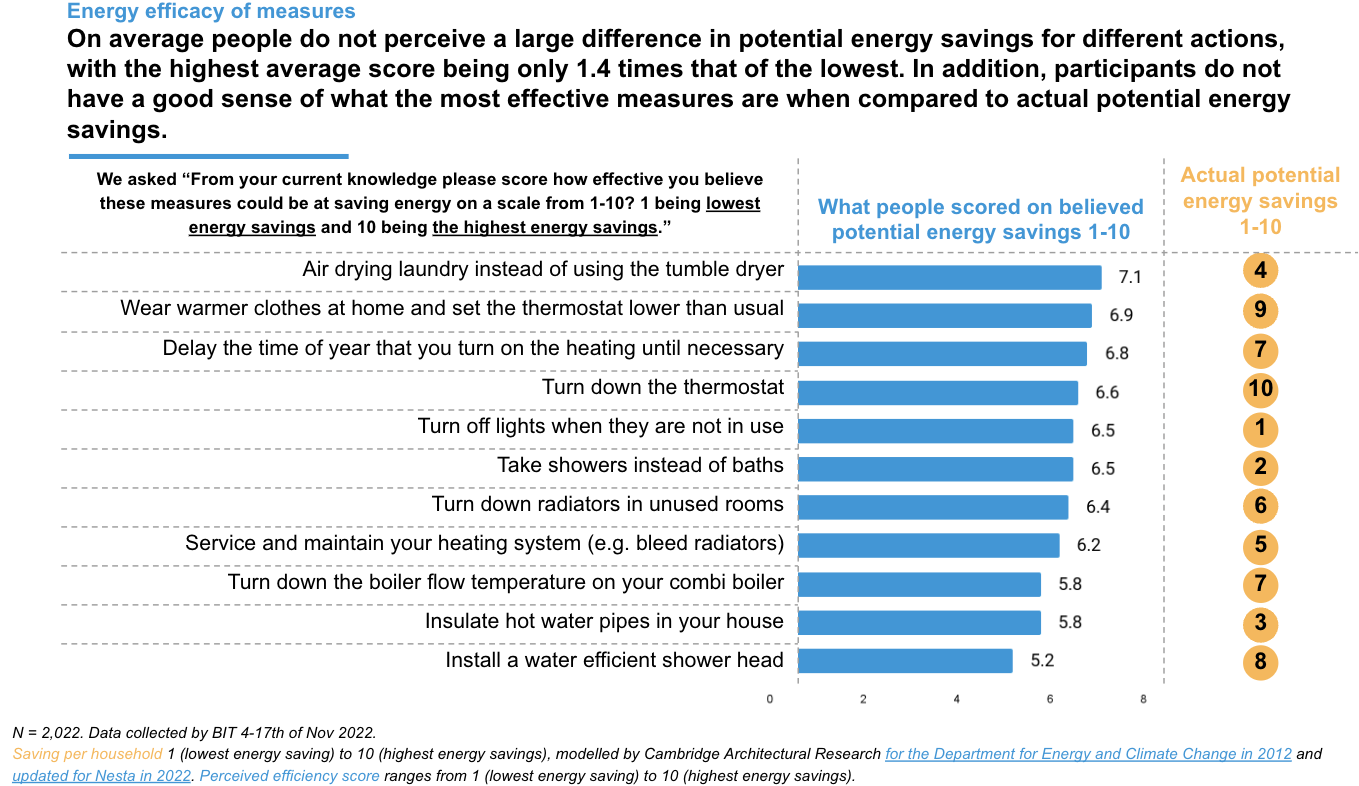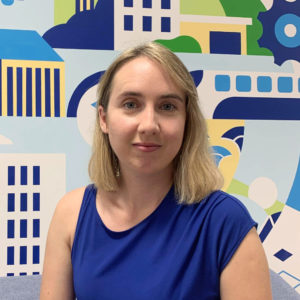As the Northern Hemisphere’s heating season continues amid the biggest energy crisis since the 1970s, The Behavioural Insights Team have conducted a rapid online survey with a UK sample of 2,022 homeowners and renters to gather evidence on people’s views of energy saving.
Specifically, we wanted to understand which energy-saving measures they plan to take and how well people understood the details of government support with bills. The first part is so we can see how well people’s intentions match what the most effective energy-efficiency measures are, and the second is how advice on energy-efficiency measures is likely to be welcomed by the wider public.
Our findings suggest that with the latter, a government communications campaign is much needed and welcome, with 7 in 10 supportive of the idea. Our study found however there is considerable variation among the public on which steps work best to save energy. But this means that a well-designed and implemented campaign can be highly impactful.
Which energy-saving steps are people prioritising?
With more than 9 in 10 concerned about the energy crisis, it is not surprising that virtually everyone said they are looking for ways to reduce their energy bills. When asked which actions they plan to take, we find the most common response is to turn off lights. This is a very salient action, very easy to do, and brings no loss of comfort (unlike turning your heating down). But it also saves very little energy thanks to the efficiency of modern LEDs.
More encouragingly we see people also prioritising turning their thermostat down (and wearing warm clothes to compensate), delaying the use of their heating, and turning off radiators in empty rooms – all big energy savers.
But many also overlook a range of other easy, very effective, set-and-forget steps like adjusting boiler flow temperature, bleeding radiators or buying a water-efficient shower head. These are also pretty big energy savers, particularly given they only take very little time, and shouldn’t reduce your comfort at all.
Figure 1. Actions people are taking or planning to take to reduce energy usage

Which actions do people think will save the most energy?
Whether or not someone plans to take a particular step is partly down to how worthwhile they think it is, but also how easy it is, whether they know how to do it, and whether they think it will reduce their comfort.
To explore what they think about how effective these actions are, we asked people how much energy they think these actions would save on a 1-10 scale, ranging from low energy savings to high energy savings (1= lowest -10= highest). We found that on average, people have zero sense of magnitude – estimating all actions save moderate amounts of energy.
Participants thought air drying laundry was the most effective action, even though it’s closer to the bottom of the real ranking. Several very effective measures – such as installing a water-efficient shower head (No.8) or turning down the boiler flow rate (No. 7) tend to fly under people’s radar.
Figure 2. Energy saving measures: Perceived efficiency vs Actual efficiency

Note on figure 2: Potential saving per household from 1 (lowest energy saving) to 10 (highest energy savings), modelled by Cambridge Architectural Research for the Department for Energy and Climate Change in 2012 and updated for Nesta in 2022.
How many people understand the UK Government’s energy price guarantee?
At BIT we have discovered that the public’s understanding of the government’s flagship energy crisis policy could be improved. Whilst 8 in 10 had heard of the Energy Price Cap, less than half actually knew what it meant (i.e. that households with typical energy usage will spend, on average, £2,500 per year).
The remaining were confused, with many thinking the cap means that all households will pay a maximum of £2,500 per year. Only around 1 in 10 understood that the cap will limit the rise of energy cost for an average household to ‘just’ 30% compared to last year.
The combined 41% who thought the Energy Price Guarantee was a maximum for all households are a group of particular concern. If we take their answers at face value, they may think that they’ll be given unlimited relief once they hit £2,500 of energy consumption – essentially being placed on an ‘unlimited free energy’ diet (with some nasty surprises when they find this is not the case).
We also tested a few different ways of phrasing the price guarantee. We increased comprehension slightly by explaining what ‘average household’ means (e.g. the number of rooms) and using a monthly figure for the price guarantee (eg £200 per month until April 2023 rather than £2,500 per year).
What form of financial support is most appealing?
We also tested the public’s support for a range of policy options. Participants saw several scenarios describing either another one-off lump sum payment (as implemented earlier this year) or a version of ‘block’ pricing (through which everyone gets low energy rates up to a point, but the unit cost increases steeply above a threshold – meaning ‘necessary’ energy use is affordable, but there is still an incentive against higher consumption).
We found the one-off lump sum to be nearly twice as popular (7 in 10 support it) as any of our block pricing options (4 in 10). The main reasons for the lack of support for block pricing were concern it wouldn’t sufficiently help with bills (not actually true, compared to the lump sum scenario) and it being more difficult to understand.
Are energy-efficient home upgrades becoming more popular?
With the cost of energy soaring, the return on investment for energy efficiency upgrades is now better than ever. Recently, the Government unveiled £1 billion worth of funding for energy-efficiency home upgrades to further encourage uptake. Our findings show that 1 in 4 say they would like to install energy-efficient home upgrades (such as LED lighting and solar panels).
However, many participants are also hesitant because they worry that future energy savings won’t be worth the outlay – perhaps because 1 in 2 expect energy prices to fall back to 2020 levels within two years.
At the same time, we found people also overestimated current savings from home upgrades. We asked participants to tell us how much they thought the ‘typical home’ would save by installing various energy efficiency measures.
People’s guesses were consistently double or even triple the correct figure. (The ‘correct’ figures were taken from Energy Saving Trust.) For instance, the average estimated annual savings from installing LED lights were three times higher than the correct figure, 12 times higher for loft insulation, and for heating controls and solar panels two times higher. The savings from adjusting one’s boiler flow temperature was the only one that was correctly guessed.
Taken together, our analysis suggests that people overestimate the financial benefits of retrofits in general but remain reluctant to pursue them, perhaps partly in light of expectations of future energy price drops. In line with behavioural science literature on the present bias, this suggests that more readily calculable (present) cost considerations trump more complex calculations involving estimations of the financial amount saved from reduced (future) energy consumption.
How to design an effective energy crisis communications campaign?
At BIT, our findings suggest that a comprehensive communication campaign on energy crisis-related action is much needed. It should focus on:
- Highlighting the most effective actions people can take, including the lesser-known ones like adjusting the boiler flow temperature and bleeding radiators.
- Dispel myths about the usefulness of long or less effective actions – like switching off lights or air drying clothes – that may be taking up a lot of headspace.
- Clarify what the energy price cap means for households. Namely, that it doesn’t mean they can use as much energy as they want and will only pay £2,500.
- Provide explanations for alternative financial support options, like block pricing, to build up public understanding and support.
- Alongside the provision of financial support for energy-efficient home upgrades, address the perception that future energy savings won’t be big enough, because the crisis is temporary. Instead, framing the upgrades within the broader context of the UK’s energy transition could help.
Discover Behavioural Science for the Sustainability Sector with BIT
Providing energy-efficient and sustainable practices to the public is a worthwhile investment, which is why at The Behavioural Insights Team we provide expert Behavioural Science services to organisations offering energy efficiency to clients.
Get in touch with our team today for more information about our range of services for the Sustainability sector, or check out our blog for more insights into our work today.








